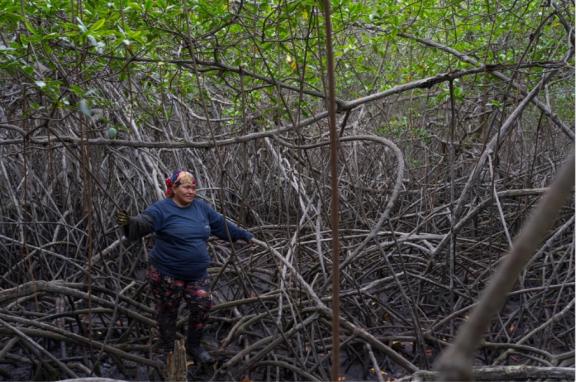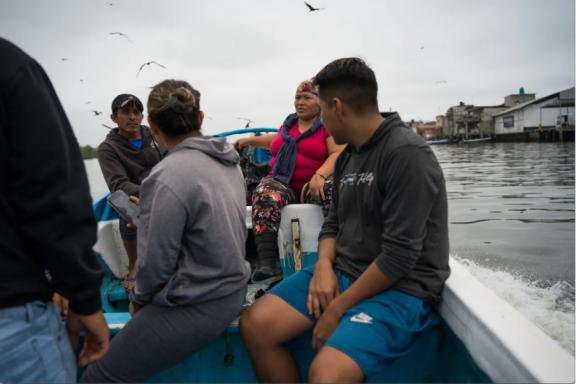Ecuador’s bold bet on mangroves: A climate solution rooted in community and capital
EL ORO, ECUADOR — On the edge of the Pacific, where land blurs into water and roots tangle beneath the tide, Ecuador’s mangrove forests stand as some of the planet’s most efficient carbon sinks. But over the past two decades, these vital ecosystems have been depleted and decimated, largely due to urbanisation and commercial shrimp farming.
A groundbreaking project backed by the Green Climate Fund (GCF) is working to reverse this damage. With a budget of USD 45.9 million and a radically inclusive approach, the “Mangroves for Climate” project (FP235) is redefining how climate finance, community conservation, and private sector cooperation can come together to tackle environmental loss - and transform it into restoration.
Mangroves, often hailed as "blue carbon" champions, store up to four times more carbon than terrestrial forests. They also serve as nurseries for marine life, protect shorelines from erosion, and support the livelihoods of thousands of coastal families. Yet in Ecuador, more than a third of these forests have disappeared under pressure from aquaculture.
Led by Ecuador’s Ministry of Environment with support from Conservation International and the GCF, the project offers a holistic solution: protect mangroves, improve local economies, and reduce emissions—all at once.
Where past conservation efforts focused on enforcement and exclusion, the Mangroves for Climate project brings shrimp farmers to the table. Recognizing that aquaculture is here to stay, the project invites farmers to become partners in restoration. They are encouraged to restore and manage mangrove areas within or near their concessions, adopt legal, sustainable practices, and participate in long-term stewardship programmes monitored with community oversight.
This engagement is supported by financial incentives and tied to measurable environmental outcomes. At the heart of the project is a results-based payment system. Unlike traditional grants, this model rewards participants only when specific outcomes—such as restored hectares or verified emissions reductions—are achieved.
To fund these results, accrued interest from GCF funds is used to provide incentive payments to shrimp farmers and communities engaged in restoration. The project is also seeking additional capital from bilateral donors, climate funds, and private investors to expand the payment system and reach more communities.
This structure introduces financial discipline and accountability into conservation, turning restoration from a cost into an investment. It’s not just about changing landscapes—it’s about changing lives. More than 89,000 people, many in vulnerable coastal regions, are direct beneficiaries. These include traditional fishers, crabbers, and families whose livelihoods depend on mangrove ecosystems.
Rather than impose external solutions, the project champions locally led climate adaptation. It trains residents as forest monitors, supports community-based mangrove management groups, provides legal tools to defend ancestral lands and challenge encroachment, and promotes alternative livelihoods that are both sustainable and culturally rooted.
This bottom-up approach empowers communities and ensures conservation is equitable, lasting, and locally relevant.
Built to Last: Strengthening Institutions
To secure long-term impact, the project integrates with Ecuador’s national governance structures. It leverages the Ecuador Mangrove Fund - a national forest finance mechanism -to channel climate finance more efficiently, deliver payments transparently, and coordinate across ministries, the private sector, and civil society.
By investing in institutional capacity, the project builds a foundation for scalable, replicable climate action beyond the current funding cycle.
A Model with Global Implications
As the world searches for inclusive, high-impact climate solutions, Mangroves for Climate offers a compelling case study. It breaks down silos; between conservation and commerce, finance and justice, environment and economy.
If it succeeds, the project won’t just restore mangroves to Ecuador’s coast. It could set a global precedent for how climate finance is deployed - with communities at the centre, the private sector at the table, and nature as the common ground.
Hear their story
Without the mangroves, the crabs are no more. Without the crabs, the community and livelihood loss is extensive.
It’s traditional crabbers like 54-year-old Neiva Carrascal whose livelihood depends on the mangrove forests, that will benefit from this project. Like many traditional crabbers in the region, she has watched helplessly as once-thriving mangrove forests are cleared—often illegally—to make way for shrimp farms. In some cases, she and others have even faced threats when they try to protect what’s left, “Our work is difficult but beautiful. This is how we survive.”
Without the mangroves, the crabs are no more. Without the crabs, the community and livelihood loss is extensive.
But that could all turn around for her and her family. With the help of the Mangroves for Climate Project, she is now able to see a future where the Mangroves thrive and the crabs return, and for the first time in a while, she is witnessing something new in the region- hope.
Neiva Carrascal takes a break from collecting crabs, which she does daily as a cangrejera, or crabber, May 10, 2022. Photo: Thomson Reuters Foundation/Kimberley Brown
Neiva Carrascal (right) with her husband Jose Sambrano (left) and their family go out to collect crabs in the mangroves just off the Bolivar Port in Machala, in southern Ecuador, May 10, 2022. Photo: Thomson Reuters Foundation/Kimberley Brown